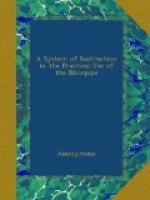When heated upon charcoal in the reduction flame, it is reduced to a metal; but, at the same moment, is volatilized, and sublimes as oxide of zinc upon the charcoal, about one line’s distance from the assay. This is likewise the case with the microcosmic salt, except that it is more easily volatilized in the reduction flame.
Carbonate of soda does not dissolve the oxide of zinc in the flame of oxidation. In the reduction flame and upon charcoal, the oxide of zinc is reduced to the metallic state, and is volatilized with a white vapor of the zinc oxide, which sublimes on the charcoal and exhibits a yellow color while hot, and which changes to white when cold. By a strong heat the reduced zinc burns with a white flame.
Moistened with a solution of cobalt oxide, and heated strongly in the flame of oxidation, zinc oxide becomes of a yellowish-green color while hot, and changes to a beautiful green color when cold.
(b.) Cadmium (Cd).—This is one of the rare metals. It occurs in combination with sulphur in greenockite, and in some ores of zinc. It was detected first in the year 1818, and presents itself as a tin-white metal of great lustre, and susceptible of a fine polish. It has a fibrous structure, crystallizes easily in regular octahedrons, presenting often the peculiar arborescent appearance of the fern. It is soft, but harder and more tenacious than tin; it can be bent, filed, and easily cut: it imparts to paper a color like that of lead. It is very malleable and ductile, and can be hammered into thin leaves. It is easily fused, and melts before it glows (450 deg.). At a temperature not much over the boiling point of mercury, it begins to boil, and distills, the vapor of the metal possessing no peculiar odor. It is unalterable in the air for a long time, but at length it tarnishes and presents a greyish-white, half metallic color. This metal easily takes fire when heated in the air, and burns with a brownish-yellow vapor, while it deposits a yellow sublimate upon surrounding bodies. It is easily soluble in acids with the escape of hydrogen, the solutions being colorless. Its salts, soluble in water, are decomposed by ignition in free air. Its soluble neutral salts change blue litmus paper to red. The salts, insoluble in water, are readily dissolved in acids.
Oxide of Cadmium (CdO).—This oxide is of a dark orange color. It does not melt, and is not volatile, not even at a very high temperature. Its hydrate is white, loses in the heat its hydratic water, and absorbs carbonic acid from the air when it is kept in open vessels.




